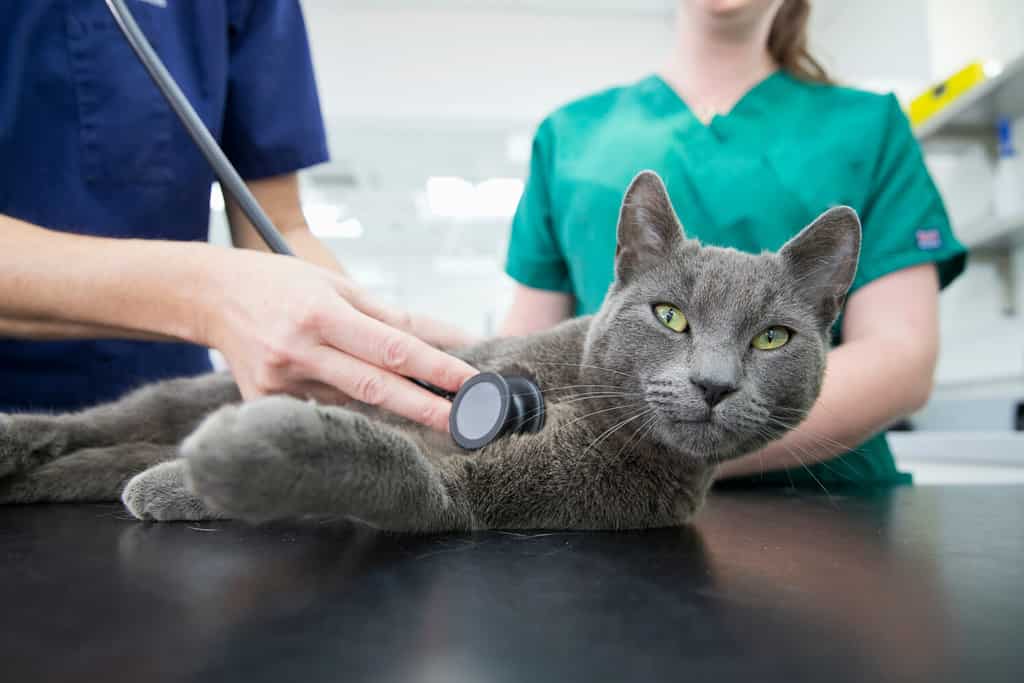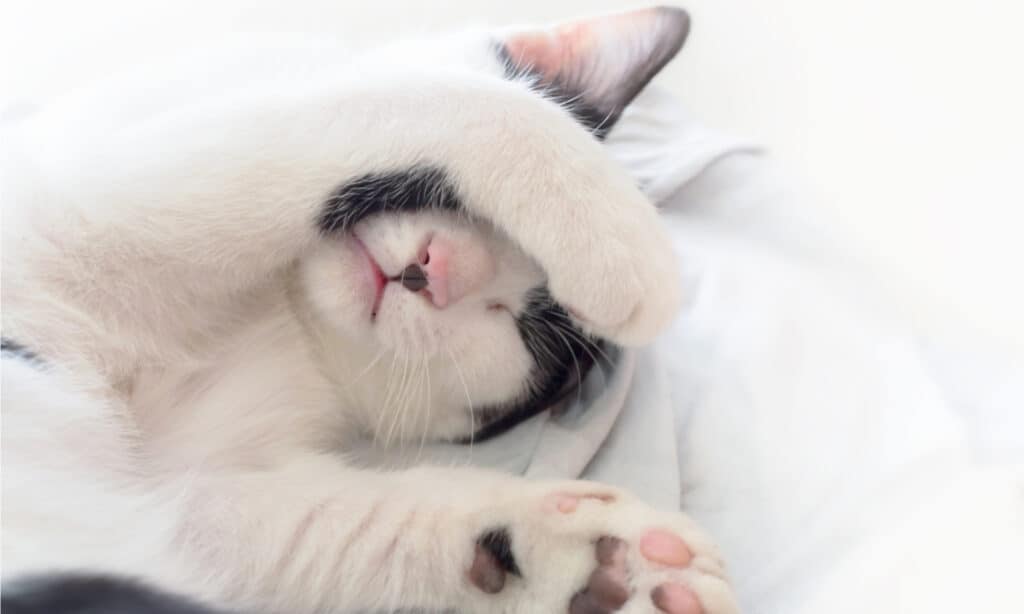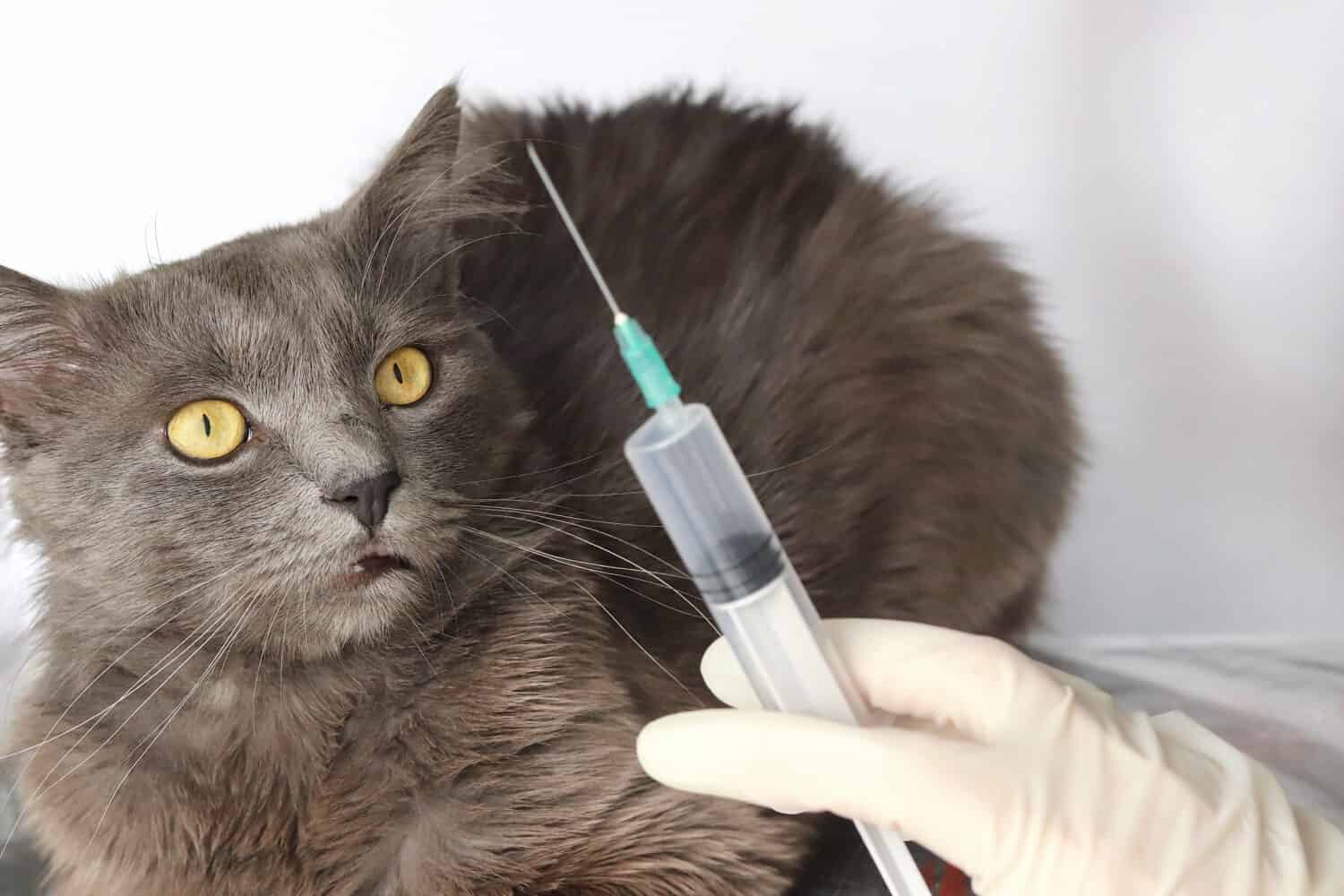
©Juice Flair/Shutterstock.com
Several years ago, I was brushing my teeth when my beautiful tuxedo cat – aptly named Leche because he looks like a dairy cow – uncharacteristically hopped into our bathtub. Initially amused, I giggled but then almost fainted when he peed blood right in front of my eyes. This was a clear sign that he needed immediate medical attention. The veterinarian confirmed that he had crystals in his urine – which almost shattered my heart – but I felt fortunate that we caught and treated his bladder issues very quickly.
Unfortunately, cats rarely communicate in such a direct manner when they aren’t well. Nor do they always demonstrate their pain or illnesses transparently. In the same way as their wild counterparts, house cats have developed deep instincts to suffer silently and without visual cues – thereby masking their vulnerabilities as a sophisticated defense mechanism against predators. Luckily, however, there are still several telltale signs that cats are sick or injured that they simply cannot disguise.
I’ve read that love is the act of paying attention, which really applies to our feline friends. After all, they rely entirely on our careful analysis of their behavior, moods, and routines to keep them healthy and pain free. No matter what, if your cat begins demonstrating odd or concerning behaviors, please trust your instincts and seek help.
Once you have an official medical diagnosis, work with your veterinarian on a treatment plan. I also encourage you to research your cats’ conditions to make sure you understand exactly what’s happening and therefore make educated decisions about their healthcare. Cornell Feline Health Center’s A-Z catalogue of health topics is a quick and fairly thorough reference guide for everything from aging to zoonotic diseases. It is a fantastic resource for all cat parents to keep handy.
Now let’s look at 16 telltale signs that your cat is sick or injured and needs to visit a veterinarian.

While cats can hide simply to relax without being disturbed, it can also mean that they aren’t feeling well.
©Africa Studio/Shutterstock.com
1. Hiding
As I just mentioned, domestic cats – like big cats in the wild – have evolved to mask their pain. This might have been a good evolutionary trick to protect them against potential threats, but it can make it hard for us to gauge the telltale signs that our cats are sick or injured. If your cat is spending an inordinate amount of time under the furniture, in the basement, below the porch, other otherwise out of view – especially if this is unusual behavior – a visit to the vet may be in order.
2. Vomiting
Acute vomiting in cats is not always cause for concern, especially if it only happens infrequently or resolves rapidly. For instance, because they invest over half of their waking hours grooming themselves – which loosens their fur which they then digest (ewww!) – cats occasionally throw up hair balls. This is rarely anything to worry about unless it is a regular occurrence. However, depending on the color, duration, and frequency, vomiting can also signal a medical emergency. Anything from infections, food allergies, pancreatitis, or more serious conditions like organ dysfunction might be at play.
Chronic vomiting is quite troublesome and absolutely necessitates a trip to the veterinarian. They will likely check for things like inflammatory bowel disease, food allergies, gastrointestinal motility disorders, neoplasia, and extra-gastrointestinal diseases, such as renal disease, hepatobiliary disease, and hyperthyroidism.
Vomiting can also be a response to poisoning, which can happen if our cats accidentally get into something they shouldn’t, for example, if they ingest or are otherwise exposed to toxic plants, foods, or other household items. On that note, here is a list of the most common cat poisons. Please do whatever you can to prevent your cats from coming into contact with any toxins. If you suspect your cat has been poisoned, contact the ASPCA Animal Poison Control Center immediately at (888) 426-4435.
3. Diarrhea
Like vomiting, a short bout of diarrhea might not be too problematic. This is refereed to as acute and can be caused by food intolerance or allergies, viral, bacterial, fungal, or protozoal infections, or metabolic diseases. However, depending on the severity and frequency of the episodes, diarrhea does require medical attention, particularly because your cat can all-too-easily become dehydrated if they cannot keep anything in their system (as is also the case with excessive vomiting).
Chronic diarrhea – defined as diarrhea that occurs frequently over time – is also problematic and can be harder to treat. Like its acute counterpart, it can be caused by a variety of health issues and needs medical intervention.
Finally, diarrhea can also be a sign of poisoning, in which case, call the poison control center immediately.
4. Lethargy

Cats love to sleep and rest, on average, between 12-16 hours of day. This is normal. However, if they seem especially groggy, sleep constantly, or lose all interest in play, they might be sick.
©Gumpanat/Shutterstock.com
Lethargy is a fancy term for extreme sluggishness. If your otherwise energetic or playful cat suddenly starts sleeping a lot, becomes listless, becomes less social, loses interest in play, or seems unaware of their surroundings, this can indicate that they are under the weather. Infections, anemia, kidney or heart disease, food poisoning, and chronic pain can all cause your cat to lose the spring in their step.
5. Inexplicable Changes in Appetite or Drinking
Cats generally don’t suddenly lose interest in food or begin gulping water for no reason. Therefore changes in eating and drinking should be taken seriously. Cats who refuse to eat may be suffering from dental disease, which makes chewing incredibly painful. Conversely, cats who are incredibly hungry even when they have proper nutrition might be diabetic since are unable to convert glucose to energy effectively. Increased thirst and urination can be also be signs of diabetes, or can signal kidney disease, hyperthyroidism, or urinary tract infections.
6. Changes in Urination or Litter Box Habits
As with increased drinking, frequent urination is concerning and often a sign of diabetes or a urinary tract infection Furthermore, Pandora Syndrome – a complex set of psychosomatic and physical symptoms caused by stress/ a dangerous lack of stimulation – can cause cats to urinate outside of the litter box. Indoor cats are particularly susceptible to this painful condition, and as a result of the agony it causes, pee all over the house, even though they do not have a urinary tract infection.
7. Bad Breath:
It isn’t normal for your cat’s mouth to smell bad. Dental disease, oral infections, gastrointestinal issues, and some cancers may be to blame for foul oral odors and all of these require medical intervention.
8. Inexplicable Weight Loss or Weight Gain
A lot of health conditions can cause our cats to lose weight quickly. These include diabetes, hyperthyroidism, kidney disease, cancer, or gastrointestinal disorders. Dental problems, too, can make it too painful for cats to eat properly. Moreover, stress, anxiety, changes in their environment (like moving or welcoming new family members), and even parasites like worms can also be at play. Finally, your cat may not be getting adequate nutrition, which you will need to resolve quickly.
Conversely, weight gain – besides potentially signaling that we are feeding our cats too much food or a food too high in calories or not giving them adequate exercise- might also be a sign of disease. Hypothyroidism and acromegaly, which can cause insulin resistance, are some common culprits. Other conditions including heart disease and feline Infectious peritonitis, which cause fluid retention, can give a cat a swollen abdomen.
9. Mood Swings or Behavioral Changes
People do not often realize that medical problems often present as behavioral issues. Therefore, any sudden and drastic behavior in your cat’s demeanor can be a cause for concern. If your normally affectionate and social cat begins to withdraw or suddenly becomes aggressive, they might be in pain or under extreme stress. Similarly, if they start yowling or making strange vocalizations, stop eating, begin urinating around the house, or otherwise acting out of character, there may be a medical reason and it is always better to investigate than to ignore.
10. Crazy Eyes
It is absolutely not normal for your cats eyes to droop, squint, or otherwise look strange. Green, yellow, or white, discharge, excessive squinting, and dilated or constricted pupils – or anisocoria (when one pupil is dilated and the other is constricted) – are all concerning. So too is the elevation of the third eyelid, which usually sits beneath the lower eyelid but can often cover part of the eyeball when a cat is ill. Cats can get eye disease, swollen tear ducts, irritation, corneal ulcers, conjunctivitis, and other painful conditions. Moreover, many retinal issues, are caused by underlying health conditions that elevate blood pressure, such as hyperthyroidism and kidney disease. These types of ocular issues can lead to blindness and need immediate professional evaluation and treatment.
11. Problems with the Skin or Coat
Most healthy cats sport a smooth, glossy, and well-groomed coat. Conversely, dull, dry, or rough fur or flaky skin or dandruff may suggest underlying issues such as nutritional deficiencies, skin problems, or hormonal imbalances. Fur loss or bald patches are also worrisome, and may be outward signs of allergies, parasites, infections, or stress-related over-grooming. Any lumps, bumps, or growths, open sores, wounds, or abscesses also merit a veterinary evaluation.
12. Coughing or Sneezing
Just like with humans, healthy cats don’t sneeze and cough all day. Respiratory symptoms like these can expose viral or bacterial infections, allergies, or more severe conditions like asthma.
13. Lameness or Limping
If your cat is having trouble walking, moving, or jumping, they may be suffering from a disorder in the musculoskeletal system. These could include broken bones or fractures, soft tissue injuries, or the onset of painful conditions like arthritis or other joint problems.
14. Fever
It is never normal for your cat’s body temperature to soar. If your cat’s temperature is out of the normal range – approximately between 100.5 to 102.5 degrees Fahrenheit (38 to 39.2 degrees Celsius – it is typically a response to an underlying health issue. Infections, inflammatory conditions, heat stroke, immune system disorders, cancer, and dental problems could be making them sick. The Spruce Pets explains how to take your cat’s temperature here.
15. Discharge from the Eye or Nose
If your cats eyes or nose are watery or have green, yellow, or white discharge – it can be a sign of respiratory infections, allergies, or eye issues such as conjunctivitis.
16. Anything You Find Strange
You live with, love, and know your cat better than anyone. If you suspect that something is wrong – even if it is not on list of telltale signs that your cat is sick or injured – trust your instincts and seek professional advice.
Emergency Symptoms to Never, Ever Ignore
Obviously, some symptoms are quite alarming and require immediate medical attention. If you cat is experiencing any of these, go to the veterinarian right way.
Trauma – which includes accidents like falling from a height or being hit by a car – can result in serious injuries. Even if you don’t see anything wrong on the outside of their body, they may be suffering from internal injuries. Difficulty breathing, abnormal gum color (blue, white, or very pale), loss of consciousness (such as collapsing or being unresponsive), and seizures are all critical symptoms that demand swift action. As do neurological signs, like dizziness, loss of balance, circling, or an inability to walk, which can indicate serious conditions such as spinal injuries or dangerous neurological conditions.
If your cat is bleeding, straining to urinate without producing urine, or has been exposed to poison, the situation is also quite dire. Additionally, severe pain, indicated by loud cries or aggression when touched, or fever (over 104 or under 99 degrees Fahrenheit), necessitate a fast response. Lastly, if a cat hasn’t eaten properly in 24 hours, it may be a sign of underlying illness or discomfort requiring immediate evaluation. In all these cases, seek veterinary immediately since timely intervention might just save your cat’s life.
Note: if you suspect your cat has been poisoned, contact the ASPCA Animal Poison Control Center immediately at (888) 426-4435.
Handy Chart of 16 Telltale Signs that Your Cat is Sick or Injured
| 16 Telltale Signs Your Cat Is Sick or Injured | Can Indicate… |
|---|---|
| 1. Hiding | Cats mask their pain, so staying out of sight can be a sign that something amiss. |
| 2. Vomiting | Infections, food allergies, inflammatory bowel disease, pancreatitis, or more serious conditions, like organ dysfunction or poisoning. |
| 3. Diarrhea | Chronic: Resistant infections, inflammatory disease, metabolic or endocrine diseases that are poorly treated, congenital diseases, and cancer. Acute: Infections, diabetes, hyperthyroidism, or poisoning. |
| 4. Lethargy | Infections, anemia, liver or kidney disease, dehydration, or chronic pain. |
| 5. Changes in Appetite or Drinking | Diabetes, dental disease, urinary tract infections, hypothyroidism, and/ or kidney disease. |
| 6. Changes in Urination or Litter Box Habits | Urinary tract infections or Pandora Syndrome. |
| 7. Bad Breath | Dental disease, oral infections, gastrointestinal issues, and some cancers. |
| 8. Gaining or Losing Weight | Diabetes, hyperthyroidism, kidney disease, cancer, feline Infectious peritonitis, or gastrointestinal disorders. |
| 9. Behavior Changes | Depending on the behavior, sudden alterations in your cat’s demeanor can signal a host of medical issues. |
| 10. Dilated or Constricted Pupils or Eye Issues | Eye disease, swollen tear ducts, irritation, corneal ulcers, conjunctivitis, hypothyroidism, and kidney disease. |
| 11. Skin or Coat Issues | Nutritional deficiencies, skin problems, hormonal imbalances, allergies, parasites, infections, or stress-related over-grooming. |
| 12. Coughing or Sneezing | Viral or bacterial infections, allergies, or asthma. |
| 13. Lameness or Limping | Musculoskeletal disorders, broken bones, soft tissue injuries, or arthritis. |
| 14. Fever | Infections, inflammatory conditions, heat stroke, immune system disorders, cancer, and dental problems. |
| 15. Discharge from the Eyes or Nose | Respiratory infections, allergies, or conjunctivitis. |
| 16. Anything you Find Suspicious | You know your cat better than anyone. Trust your instincts and seek professional help. |
NOTE: This article is not meant to substitute for the advice of medical professionals, nor intended to diagnose your cats. When in doubt, always consult a veterinarian.
Thank you for reading! Have some feedback for us? Contact the AZ Animals editorial team.








